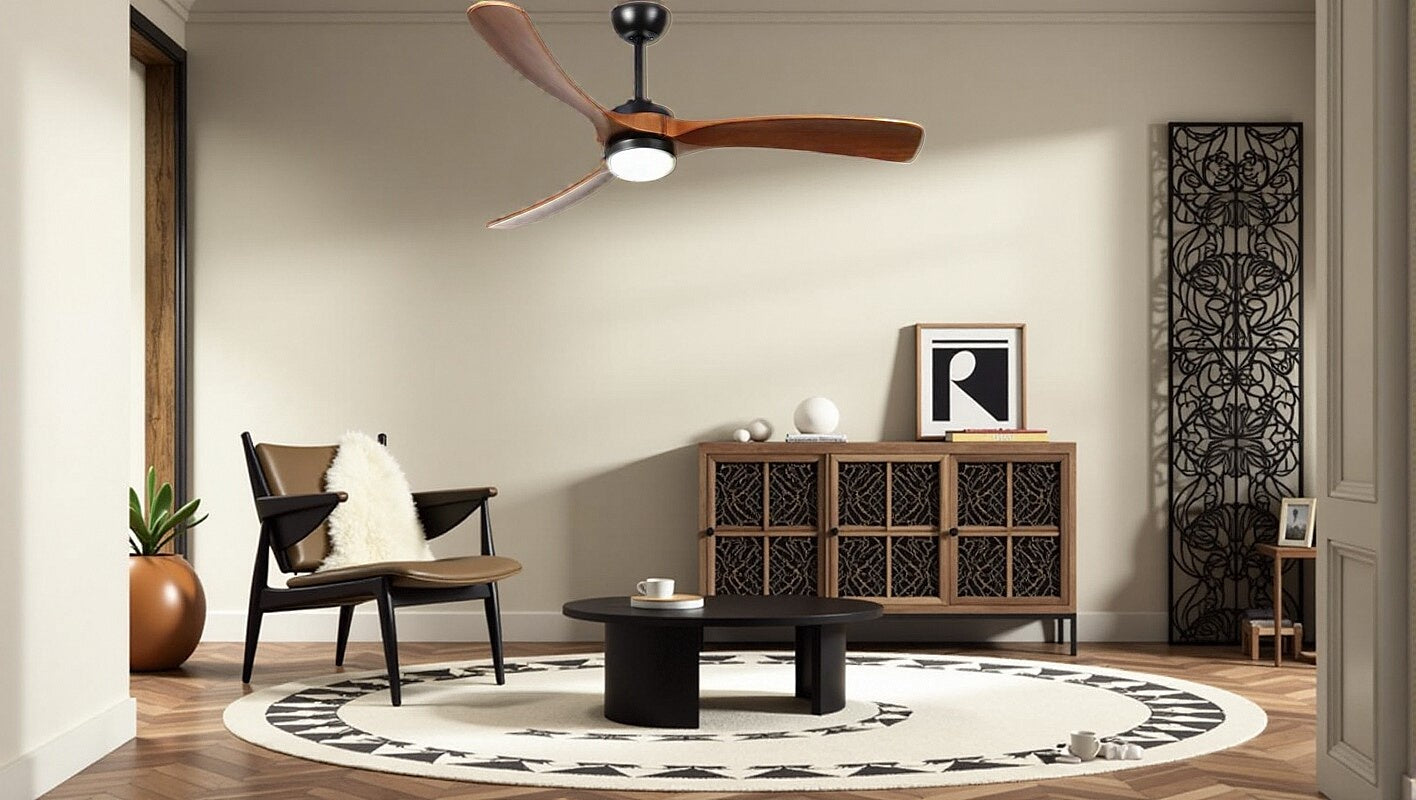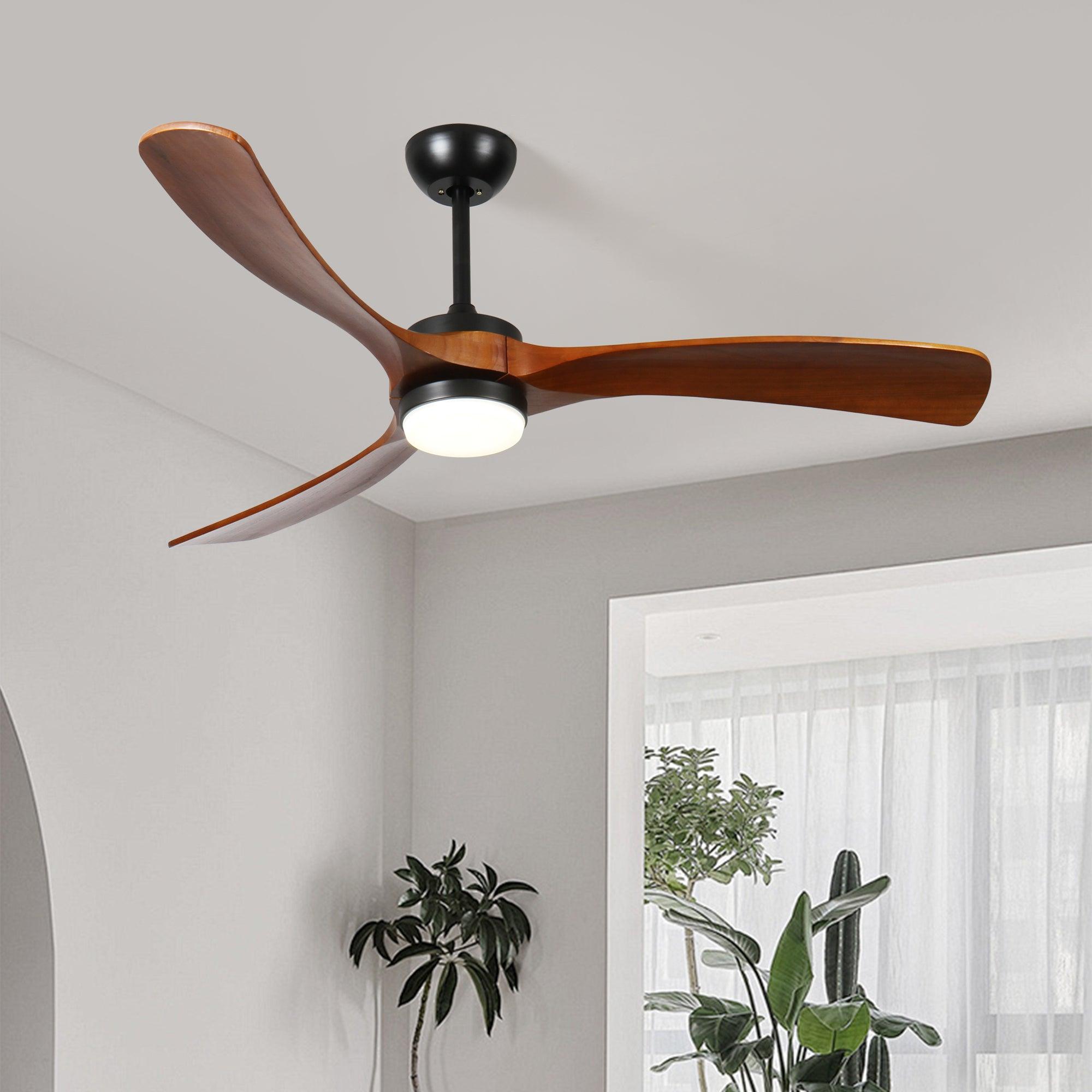
You want a ceiling fan that delivers both function and style. A walnut ceiling fan stands out for its classic look and reliable performance. These fans work well in living rooms, bedrooms, and outdoor patios. Many ceiling fan models use solid wood, which adds strength and elegance. Outdoor fans face harsh weather, so you need a ceiling fan built to last. Fans with advanced features offer comfort and energy savings. Choose fans that match your space and needs for the best results.
Key Takeaways
- Choose indoor or outdoor walnut ceiling fans based on your space and weather conditions.
- Match fan size and blade span to your room size for optimal airflow and comfort.
- Select fans with solid walnut blades and matte finishes for durability and style.
- Look for damp or wet ratings and corrosion-resistant parts for outdoor fan longevity.
- Energy-efficient fans with DC motors and LED lighting save money and reduce noise.
- Use remote or smart controls for easy adjustment of fan speed, lighting, and timers.
- Install fans properly with correct height and secure mounting for safety and performance.
- Regular cleaning and seasonal care keep your walnut ceiling fan working well for years.
Choosing a Walnut Ceiling Fan
Indoor vs. Outdoor
When you choose a ceiling fan, you must first decide if you need it for indoor or outdoor use. Indoor fans work well in living rooms, bedrooms, and offices. Outdoor ceiling fans are built to handle moisture, temperature changes, and even rain. You should look for outdoor rated ceiling fans if you plan to install one on a patio, porch, or gazebo.
Outdoor ceiling fans come in two main types: damp-rated ceiling fans and wet-rated ceiling fans. Damp-rated ceiling fans are safe for covered outdoor spaces where they may face humidity but not direct water. Wet-rated ceiling fans can handle direct rain, snow, and even salty air. These fans use corrosion-resistant materials like stainless steel and powder-coated finishes. Sealed motors keep moisture out, which helps the fan last longer. You may also see IP ratings on some fans. These ratings show how well the fan resists dust and water. Always match the fan’s rating to your outdoor environment for safety and durability.
Tip: For coastal or rainy areas, always choose wet-rated ceiling fans to prevent rust and damage.
Size & Airflow
The size of your ceiling fan and its airflow matter for comfort and efficiency. You should match the fan’s blade span and cfm (cubic feet per minute) to your room size. A fan that is too small will not move enough air. A fan that is too large may overpower a small space.
Here is a quick guide to help you choose the right blade span:
|
Room Size (sq ft) |
Recommended Blade Span (inches) |
|---|---|
|
Up to 75 |
29 to 36 |
|
76 to 144 |
36 to 42 |
|
145 to 225 |
44 to 50 |
|
226 to 400 |
50 to 60 |
|
Over 400 |
60 or larger |
You should also check the cfm rating. This number tells you how much air the fan moves. Higher cfm means better airflow efficiency. For example, a small bedroom needs a fan with 1,000 to 3,000 cfm. A large living room or outdoor area may need a fan with 5,500 cfm or more. The chart below shows the recommended cfm for different room sizes:
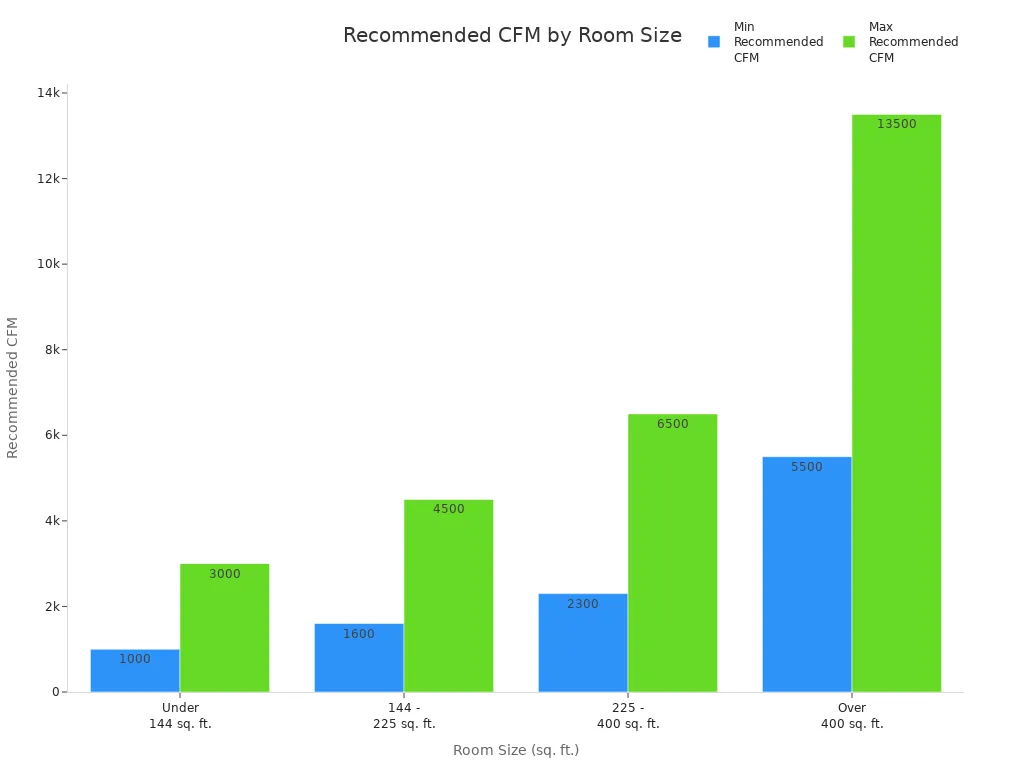
If your room has a high ceiling, use a downrod to lower the fan for better airflow. For very large or oddly shaped spaces, you may need more than one fan to keep air moving evenly.
Material & Finish
The material and finish of your walnut ceiling fan affect both its look and how long it lasts. Solid walnut blades offer natural beauty, strength, and stability. These blades provide quiet operation and strong airflow. With regular dusting and occasional polishing, solid walnut can last for decades and develop a rich patina over time.
Engineered wood or MDF blades cost less and look similar, but they do not last as long as solid walnut. For outdoor ceiling fan selection, you should choose fans with solid wood blades and matte metal finishes. Matte finishes resist fading, rust, and corrosion better than painted finishes, especially in harsh outdoor conditions. Outdoor rated ceiling fans with these features will keep their appearance and performance for years.
Note: Always check for corrosion-resistant hardware and sealed motors when choosing outdoor ceiling fans. These features protect your investment and ensure long-lasting performance.
Weather Resistance
When you select a ceiling fan for outdoor spaces, you must pay close attention to weather resistance. Outdoor ceiling fans face challenges like humidity, rain, and temperature swings. You want your fan to last, so always check if it is rated for outdoor use. Outdoor rated ceiling fans come in two main types: damp-rated ceiling fans and wet-rated ceiling fans. Damp-rated ceiling fans work well in covered patios or porches where they avoid direct water but still face moisture. Wet-rated ceiling fans handle direct rain, snow, and even salty air. These fans use sealed motors and corrosion-resistant materials to prevent rust and damage.
Outdoor ceiling fans often use solid wood blades with special finishes. These finishes protect the wood from swelling or cracking. You should also look for fans with powder-coated or stainless steel hardware. This hardware resists rust and keeps your fan looking new. Outdoor fans with high cfm ratings move more air, which helps keep your space cool even on hot days. Always match the fan’s rating to your environment. For example, if you live near the coast, wet-rated ceiling fans offer the best protection.
Tip: Place your outdoor ceiling fan under a roof or awning when possible. This extra cover extends the life of your fan and keeps it running smoothly.
Energy Use
Energy use matters when you choose a ceiling fan for your home or outdoor area. Fans with high airflow efficiency save you money and help the environment. You should look for ceiling fans with energy efficiency certifications. ENERGY STAR is the main certification for walnut ceiling fans. This label means the fan meets strict standards for energy use and performance. For example, the Minka-Aire F568-BCW Supra Belcaro Walnut 52" Ceiling Fan carries the ENERGY STAR label. This fan uses less electricity and reduces your utility bills.
Many walnut ceiling fans, such as the 70" Visual Comfort Maverick Walnut Ceiling Fan and the 60" Visual Comfort Maverick Walnut Wood LED Ceiling Fan, also have ENERGY STAR certification. These fans use advanced motors and LED lighting to cut down on energy waste. You can also save energy by using the fan’s timer or remote control to turn it off when not needed. Fans with multiple speed settings let you adjust airflow and cfm to match your comfort level and save power.
Installation
Proper installation ensures your ceiling fan works safely and efficiently. Always follow the manufacturer’s instructions. For outdoor ceiling fans, use mounting brackets and hardware rated for outdoor use. This prevents rust and keeps the fan secure. You should install the fan at least 7 feet above the floor and 18 inches from walls for best airflow. If your ceiling is high, use a downrod to lower the fan. This improves cfm and keeps air moving in large outdoor spaces.
Many ceiling fans come with three mounting options: standard, low, or angled. Choose the one that fits your ceiling type. Outdoor rated ceiling fans often include extra seals and gaskets to block moisture. Make sure all wiring is safe and dry, especially for outdoor installations. If you feel unsure, hire a professional to install your fan. This step protects your investment and ensures your fan runs smoothly for years.
Features
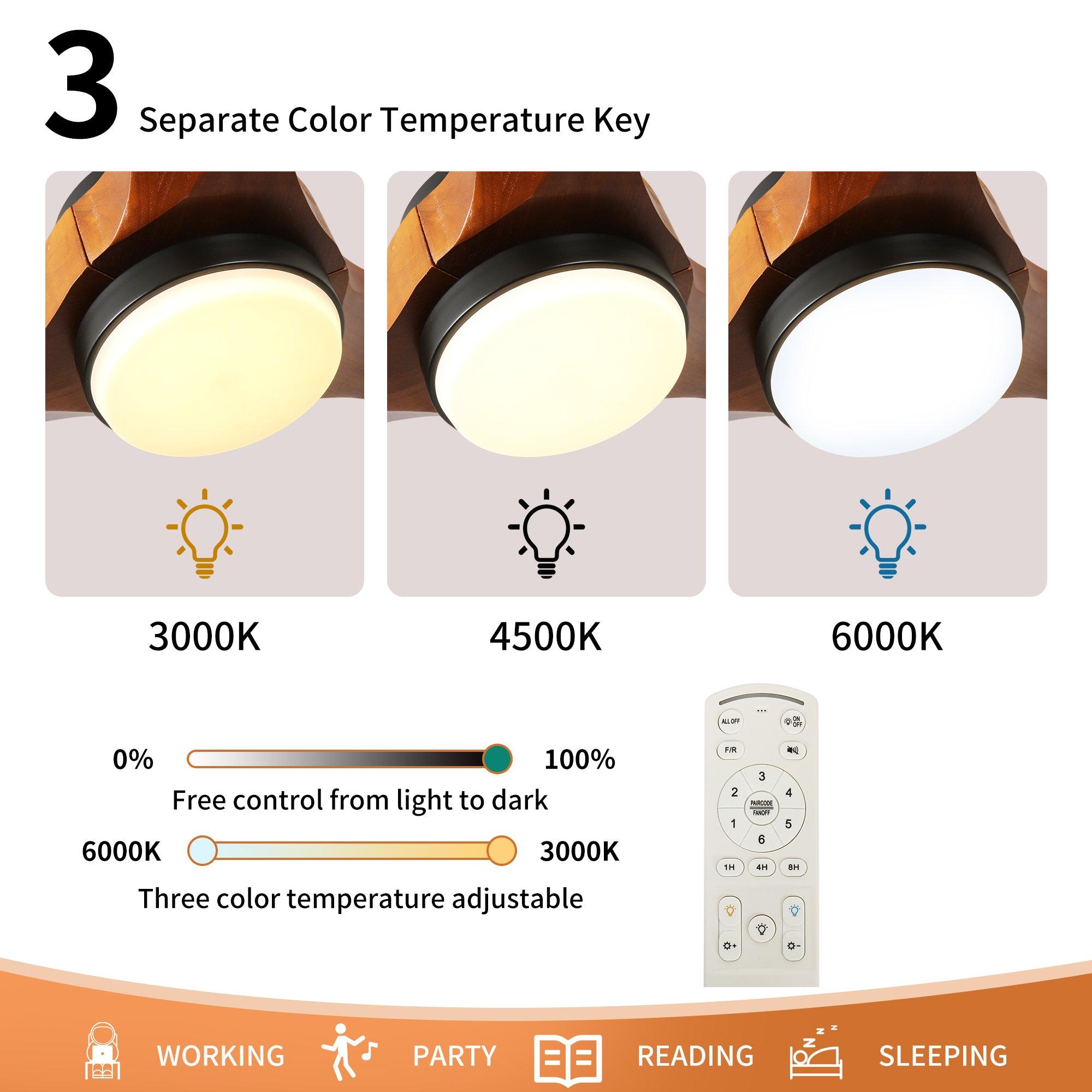
Motor Quality
When you choose a ceiling fan, you should pay close attention to the motor. The motor is the heart of the ceiling fan and determines how well it performs. Modern walnut ceiling fans often use upgraded DC motors. These motors run quietly, sometimes as low as 30 dB, and deliver strong air movement. You can use these fans in bedrooms, living rooms, or even commercial spaces without worrying about noise. DC motors also use less energy than traditional AC motors, which helps you save on electricity bills.
A pure copper DC motor stands out for its durability and silent operation. This type of motor ensures safety and stability for your ceiling fan. You can expect a longer lifespan from these fans. Many ceiling fans with DC motors offer reversible airflow. This feature lets you change the direction of the blades. In summer, you can set the fan to push cool air down. In winter, you can reverse the direction to circulate warm air. This flexibility helps you stay comfortable all year and reduces energy costs. Multiple speed settings give you more control over airflow, making these fans a smart choice for any space.
Blade Design
Blade design plays a big role in how well your ceiling fan moves air. The pitch and shape of the blades affect airflow efficiency. Walnut ceiling fans often feature solid wood blades with unique shapes. A higher blade pitch, such as those found on some premium fans, increases airflow and makes the fan more effective in large rooms.
|
Fan Model |
Blade Pitch (degrees) |
Blade Shape/Material |
Airflow Efficiency Impact |
|---|---|---|---|
|
58 inch Riviera with Arbor 100 |
Extra high pitch |
Solid wood, leaf-shaped blades (including walnut) |
High blade pitch combined with large solid wood blades enhances airflow efficiency significantly. |
|
Matthews Eliza |
27 |
Unique blade design |
Maximizes air movement at blade edges, improving airflow efficiency. |
|
Kichler Ridley II |
14 |
Walnut blades |
Lower blade pitch results in moderate airflow; blade pitch affects airflow and energy consumption. |
|
Kichler Ferron |
25 |
Not specified |
Higher blade pitch contributes to greater airflow and less energy consumption. |
You should look for ceiling fans with solid walnut blades and a high blade pitch if you want strong airflow. The shape of the blades, such as leaf-shaped or curved, also helps move air more efficiently. These design choices make walnut ceiling fans both stylish and functional. Fans with well-designed blades can cool large areas and improve comfort in any room.
Lighting
Lighting is another important feature in many walnut ceiling fans. Most modern fans come with integrated LED lighting. LED lights use less energy than traditional bulbs, which helps you save money on electricity. You can find ceiling fans with adjustable LED lights that let you change the color temperature. This flexibility allows you to create the right mood for any space.
- Walnut ceiling fans most commonly feature LED lighting options.
- LED lights are more energy-efficient than traditional bulbs.
- Integration of LED lighting helps reduce electricity costs.
- LED lighting in walnut outdoor ceiling fans combines style, function, and energy savings.
LED lighting adds both style and function to your ceiling fan. You can enjoy bright, clear light while keeping your energy use low. Many fans let you control the lighting with a remote, making it easy to adjust brightness or color. This feature is especially useful in outdoor ceiling fans, where you need reliable lighting for patios or covered decks. Choosing a ceiling fan with LED lighting ensures you get the best mix of comfort, efficiency, and modern design.
Remote & Smart
Modern ceiling fan technology gives you more control and convenience than ever before. Many ceiling fan models now include remote controls, making it easy to adjust settings without leaving your seat. With a remote, you can change the fan speed, turn the light on or off, and even set a timer. This feature is especially helpful in large rooms or outdoor spaces where wall switches may not be close by.
Some ceiling fans also offer smart features. You can connect these fans to your home Wi-Fi network and control them using a smartphone app or voice commands through smart assistants like Alexa or Google Assistant. Smart ceiling fans let you schedule operation times, adjust speed, and change lighting from anywhere. This technology helps you save energy and keeps your space comfortable at all times.
Here are some benefits of remote and smart features in ceiling fans:
- Adjust fan speed and lighting with a single button press.
- Set timers to turn the fan off automatically.
- Control multiple fans in different rooms from one device.
- Use voice commands for hands-free operation.
- Monitor energy use and optimize comfort.
Tip: If you want the most flexibility, choose a ceiling fan with both remote and smart features. This combination gives you full control over your fans, whether you are at home or away.
Noise
Noise level is an important factor when selecting a ceiling fan for your home or outdoor area. You want a fan that provides strong airflow without disturbing your peace. Most modern fans, especially those with solid wood blades like walnut, operate quietly. However, the material and design can affect how much noise the fan makes.
You can compare noise levels of different ceiling fans by looking at their decibel (dB) ratings. For example, fans with plywood blades tend to be quieter, averaging around 20 dB. Solid wood fans, including those with walnut blades, usually produce about 35 dB. This level is similar to a quiet library and is comfortable for most indoor and outdoor settings. Plastic and wood + crystal fans also fall in the 35 dB range. Some advanced models, like the Generation Lighting Maverick, offer noise levels from 32 dB at low speed to 49 dB at high speed.
|
Brand |
Blade Material |
Noise Level (dB) |
|---|---|---|
|
Amico |
Plywood |
20 |
|
Sofucor |
Solid Wood (includes walnut) |
35 |
|
Fanbulous |
Solid Wood |
35 |
|
Asyko |
Wood + Crystal |
35 |
|
Orison |
Plastic |
35 |
|
Generation Lighting Maverick |
Not specified |
32 (low speed) to 49 (high speed) |
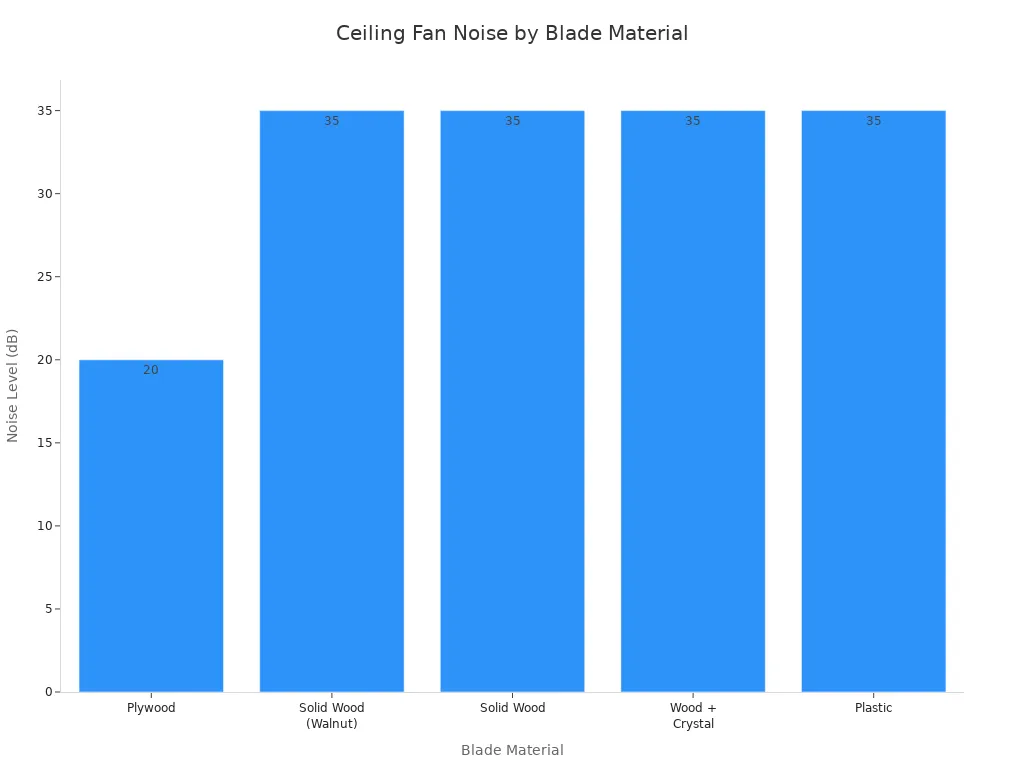
You should consider the noise level when choosing a ceiling fan for bedrooms, living rooms, or outdoor patios. Fans with solid walnut blades balance strong airflow with quiet operation, making them a great choice for most spaces. Always check the noise rating before you buy to ensure your fan meets your comfort needs.
Best Outdoor Ceiling Fans
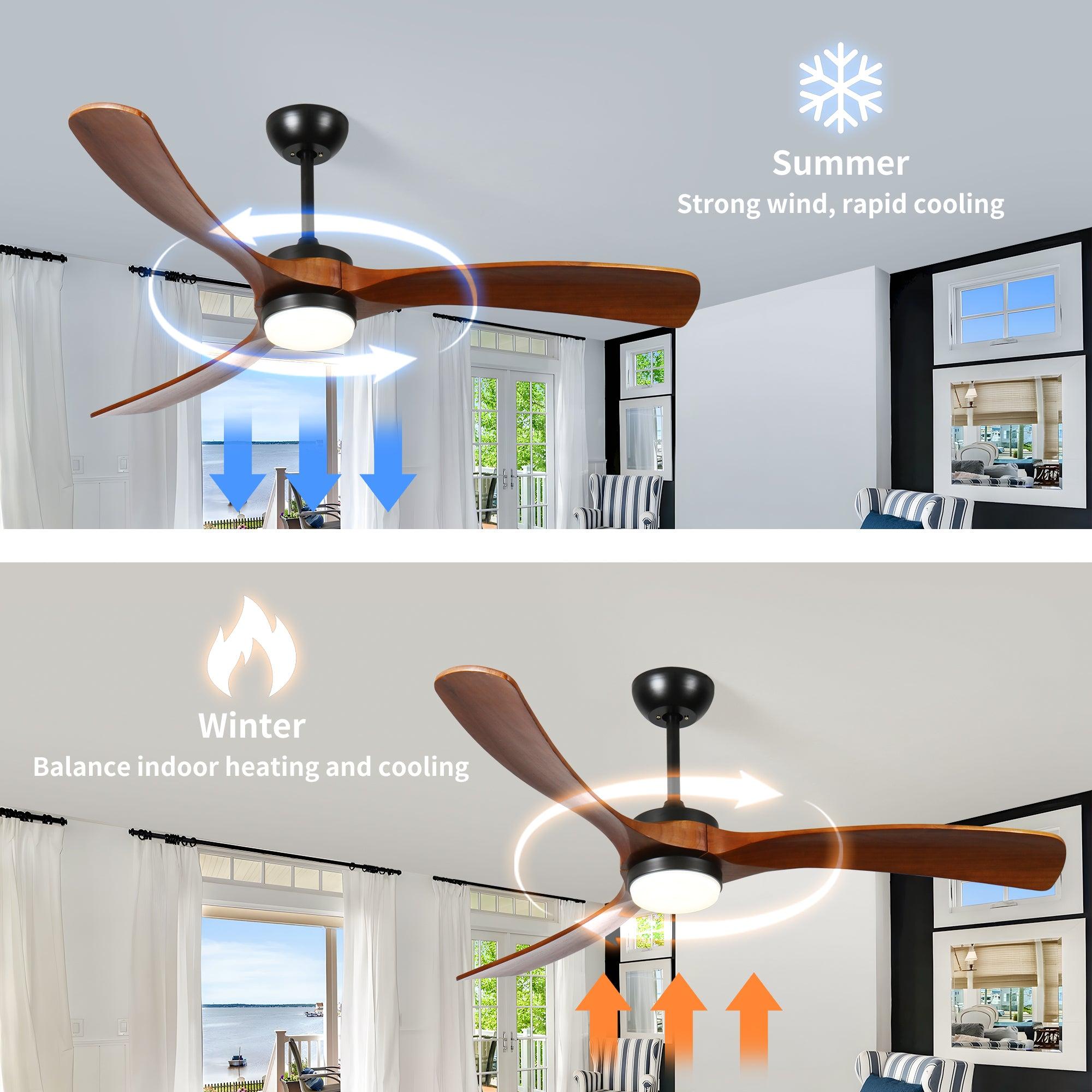
Best Walnut Ceiling Fan
If you want a walnut ceiling fan that stands out for both style and performance, the Rackora 60" Walnut Solid Wood Ceiling Fan Light is a top choice. This model combines a modern look with the natural beauty of solid walnut blades. You get ultra-powerful air movement from its three-blade design, which keeps your space comfortable in every season. The reversible motor lets you switch airflow direction, so you can use the fan for cooling in summer and for circulating warm air in winter.
You control the fan and its integrated LED light with a remote. You can pick from six fan speeds and three light color temperatures. The timer function helps you save energy by turning the fan off automatically. The whisper-quiet motor makes this fan perfect for large living rooms, bedrooms, or even covered patios. The sturdy build and weather-resistant finish mean you can use it as one of the best outdoor ceiling fans for both indoor and outdoor spaces.
Tip: The Rackora 60" Walnut Solid Wood Ceiling Fan Light offers a three-position mounting system. You can install it on standard, low, or angled ceilings, making it flexible for many room layouts.
Best for Indoors
Some fans work best inside your home. The Minka-Aire F568-BCW Supra Belcaro Walnut 52" Ceiling Fan is a great example. This fan features a classic walnut finish and a five-blade design. It fits well in bedrooms, offices, and living rooms. The ENERGY STAR certification means it uses less electricity, so you save on your utility bills. The fan runs quietly and provides steady airflow, making it ideal for spaces where you want comfort without noise.
Another strong indoor option is the Visual Comfort Maverick Walnut Ceiling Fan. This fan comes in both 60" and 70" sizes. The solid walnut blades and sleek design add elegance to any room. The DC motor ensures quiet operation and high energy efficiency. You can use the remote to adjust speed and lighting. These features make it one of the best outdoor ceiling fans for indoor use, especially if you want a fan that looks good and works well.
For indoor spaces, always check the fan’s airflow rating and noise level. A quiet fan with strong airflow improves comfort in bedrooms and living areas.
Dual-Use Picks
You may want a fan that works well both indoors and outdoors. Some models are designed for dual use, offering durability and style in any setting. These fans have weather-resistant finishes, rust-proof hardware, and motors that handle moisture. You can install them in living rooms, patios, or even open decks.
Here is a comparison of top dual-use walnut ceiling fan models:
|
Model Collection |
Blade Finish |
Size |
Indoor/Outdoor Use |
UL Rating |
Key Features for Dual Use |
|---|---|---|---|---|---|
|
Carve Collection |
Dark Walnut Blades |
60" 3-Blade |
Yes |
UL Damp/Wet* |
Weather resistant, rust-resistant hardware, mold/mildew resistant |
|
Generation Lighting Cruise |
American Walnut |
52" 5-Blade |
Yes |
UL Wet Rated |
Moisture-resistant motor, all-weather blades, direct outdoor use |
*The Carve Collection is suitable for both indoor and outdoor use, with at least a UL damp rating. The Generation Lighting Cruise is UL wet rated, so you can use it in areas exposed to rain or snow.
The Generation Lighting Cruise 52" 5 Blade Ceiling Fan uses American Walnut blades and a moisture-resistant motor. The all-weather ABS blades last a long time, even in wet environments. You can use this fan on open patios, covered porches, or inside your home. The reversible 3-speed motor and optional remote control add convenience. You can also add a light kit if you want more functionality. These features make it one of the best outdoor ceiling fans for dual use.
Choose dual-use fans if you want flexibility. You can move them between indoor and outdoor spaces as your needs change.
Budget Options
You do not need to spend a fortune to enjoy the benefits of outdoor ceiling fans. Many budget-friendly models offer reliable performance and style for your outdoor spaces. When you look for affordable options, focus on fans that provide weather resistance, solid airflow, and easy installation. These features ensure your fan will last through changing seasons and keep your patio or porch comfortable.
Here are some tips for choosing budget outdoor ceiling fans:
- Check for Damp or Wet Ratings: Make sure the fan is rated for outdoor use. Damp-rated fans work well under covered patios, while wet-rated fans can handle direct rain.
- Look for Solid Blade Materials: Many budget fans use engineered wood or ABS plastic blades with a walnut finish. These materials resist warping and moisture.
- Simple Controls: Most affordable fans come with pull chains or basic remotes. These controls are easy to use and maintain.
- Energy Efficiency: Choose fans with efficient motors and LED lighting to save on electricity bills.
Tip: You can find budget outdoor ceiling fans with reversible motors. This feature lets you use the fan for cooling in summer and for circulating warm air in winter.
Some popular budget models include the Honeywell Belmar 52" Outdoor Ceiling Fan and the Harbor Breeze Twin Breeze. These fans offer good airflow and weather resistance at a lower price point. You can install them in gazebos, porches, or even garages. While they may not have advanced smart features, they deliver reliable comfort for your outdoor areas.
Premium Choices
If you want the best outdoor ceiling fans with advanced features and designer finishes, premium models stand out. These fans combine smart technology, high airflow, and luxury materials to create a statement in any outdoor space. You can control these fans with your voice or smartphone, set schedules, and adjust lighting to match your mood.
The table below highlights some top premium walnut ceiling fans:
|
Model Name & Series |
Blade Material & Finish |
Advanced Features |
Designer |
Price Range |
Additional Info |
|---|---|---|---|---|---|
|
Linden 52 Ceiling Fan |
American Walnut Reversible Blades |
Smart controls, LED lighting, scheduling, high airflow |
Barbara Barry, Chapman & Myers, Sean Lavin |
$119.20 - $223.20 |
Multiple finishes available |
|
Clarity 56 Hugger LED Fan |
American Walnut Reversible Blades |
Smart controls, LED light kit, high airflow |
Sean Lavin |
$399.20 |
Designer finish, compact hugger style |
|
Maverick 60 Ceiling Fan |
Dark Walnut or Koa Blades |
Smart controls, LED light kit, powerful airflow |
Visual Comfort |
$799.00 - $999.00 |
Premium materials, multiple finishes |
You get more than just a fan with these premium choices. You enjoy features like:
- Smart Controls: Adjust speed, lighting, and schedules from your phone or with voice commands.
- Designer Finishes: Hand-applied finishes and natural walnut blades add elegance to your outdoor area.
- High Airflow: These fans move a lot of air, making them perfect for large patios or decks.
- LED Lighting: Integrated LED kits provide bright, energy-efficient light for evening gatherings.
Note: Premium outdoor ceiling fans often come with longer warranties and better customer support. This gives you peace of mind for your investment.
When you choose a premium fan, you upgrade both the comfort and style of your outdoor living space. These fans work well in luxury homes, upscale patios, or any area where you want the best performance and design.
Installation & Care
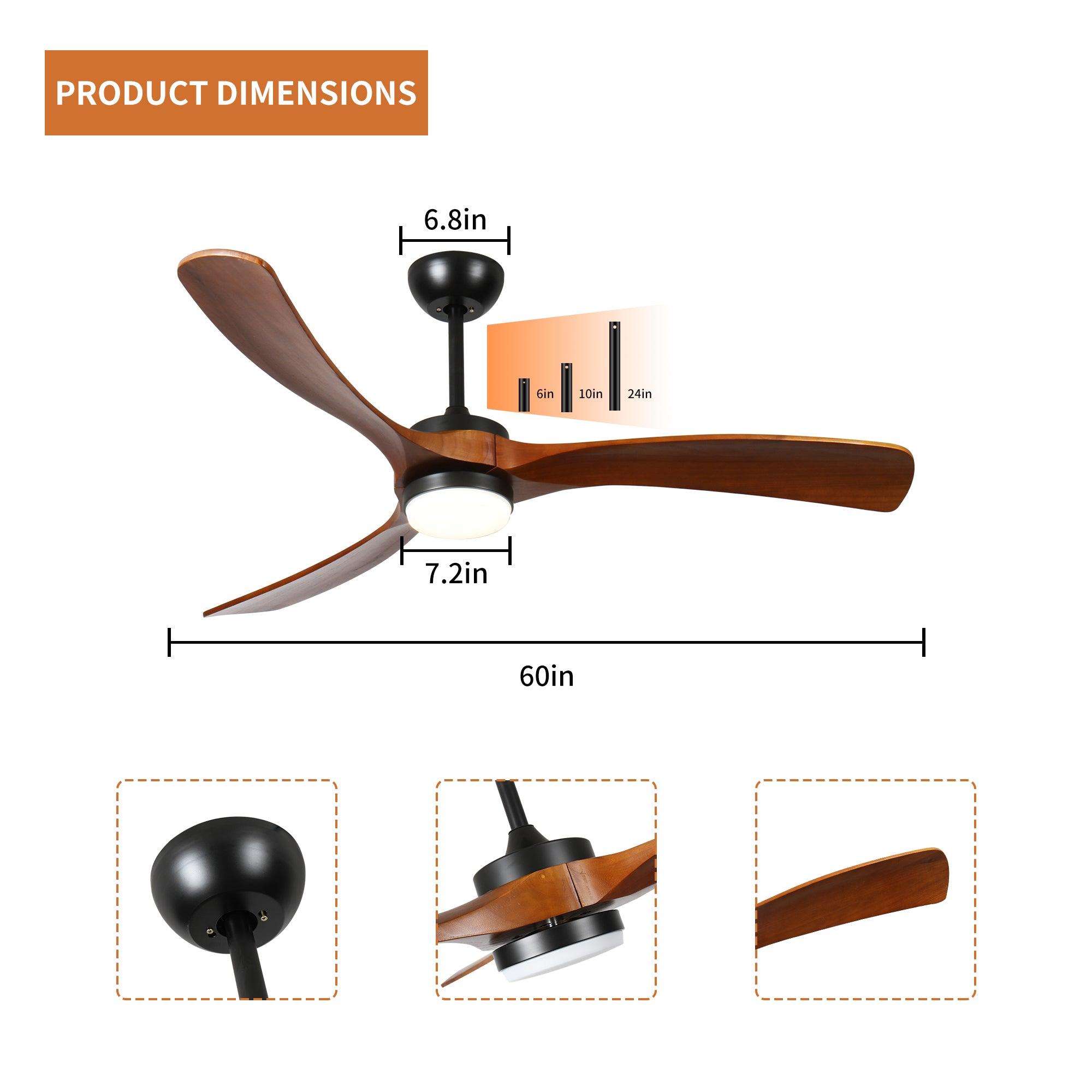
Placement
Proper placement of your walnut ceiling fan ensures you get the best airflow and efficiency in any space. Start by measuring your room to determine the right blade span. For small rooms under 75 square feet, choose fans with blades between 29 and 36 inches. Medium rooms up to 225 square feet work well with 44 to 54-inch fans. Large rooms or open floor plans may need fans up to 72 inches or even multiple fans for full coverage.
|
Room Size (sq ft) |
Recommended Blade Span (inches) |
Placement Notes |
|---|---|---|
|
Less than 75 |
29 to 36 |
Small rooms may use smaller fans or none |
|
76 to 144 |
36 to 44 |
Suitable for small to medium rooms |
|
144 to 225 |
44 to 54 |
Medium rooms |
|
225 to 400 |
50 to 72 |
Larger rooms; consider larger fans |
|
Greater than 400 |
Multiple fans recommended |
Large spaces require more than one fan |
Hang your ceiling fan so the blades sit 7 to 9 feet above the floor. This height allows for optimal air movement. Place the fan in the center of the room or outdoor area to avoid airflow blockages. Avoid corners or spots near tall furniture. For outdoor patios or decks larger than 400 square feet, install more than one fan to keep air circulating.
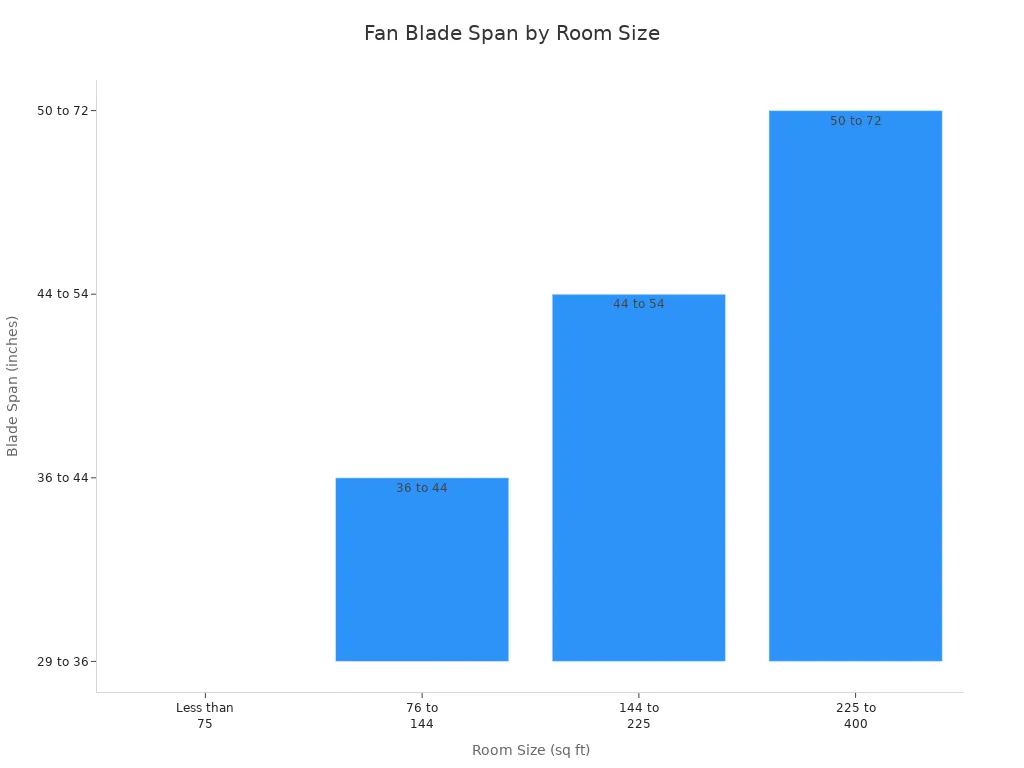
Flush-mount fans work best for standard 8-foot ceilings, while downrods help in rooms with higher ceilings. Always check that your fan is rated for outdoor use if you plan to install it outside. This ensures safety and long-term performance.
Cleaning
Regular cleaning keeps your walnut ceiling fan looking great and running smoothly. Dust and dirt can build up on the blades and motor, reducing efficiency and causing wear. Use these simple steps to maintain your fan:
- Dust the blades every 2-3 months with a microfiber cloth or a soft brush.
- Wipe the motor housing and light fixtures gently to remove grime.
- For outdoor fans, clean more often to remove pollen, insects, and moisture.
- Use a sturdy ladder and turn off the power before cleaning.
- If your fan wobbles, check and balance the blades to prevent damage.
Keeping your fan clean not only preserves its finish but also extends its lifespan.
Seasonal Tips
Outdoor ceiling fans need extra care as the seasons change. Follow these tips to keep your fan in top shape year-round:
- Clean the blades at least once a month with a soft, damp cloth, then dry them to prevent moisture damage, especially for walnut blades.
- Remove dust from the motor housing using a dry or barely damp cloth. Use a fine brush or compressed air for vents.
- Inspect all screws and fastenings every three to six months to ensure everything stays tight and secure.
- For older fans, lubricate moving parts like shaft bearings every 6 to 12 months, following the manufacturer’s instructions. Most modern fans do not need lubrication.
- In outdoor spaces, check for signs of rust or corrosion and address them quickly to prevent further damage.
By following these steps, you help your walnut ceiling fan deliver reliable performance in both indoor and outdoor environments.
Safety
When you install or maintain a walnut ceiling fan, safety should always come first. You protect yourself, your family, and your property by following a few important rules. Ceiling fans are electrical devices with moving parts, so you must treat them with care and respect.
Before you begin any installation or maintenance, always turn off the power at the circuit breaker or fuse box. This step prevents electric shock and keeps you safe while working. Never rely on just flipping a wall switch. Double-check that the power is off before you touch any wires.
You should use a qualified, licensed electrician for all wiring tasks. Electrical codes can be complex, and mistakes may cause fire or injury. An electrician ensures your fan meets all national and local codes. Always use UL listed junction boxes and mounting hardware rated for ceiling fans. The mounting structure must support at least 50 pounds to prevent the fan from falling.
Here are some key safety steps to follow during installation and maintenance:
- Turn off power at the circuit breaker or fuse box before starting work.
- Use only UL listed junction boxes and hardware rated for ceiling fans.
- Securely attach the fan to a building support structure that can handle the fan’s weight.
- Maintain at least 7 feet of clearance from the floor to the blade’s edge.
- Make sure the blades have enough space to rotate freely without hitting walls or objects.
- Do not install the fan in wet conditions unless it is specifically rated for outdoor use.
- Never insert objects between moving blades or bend the blades during installation or cleaning.
- Do not disassemble or modify the fan or use non-original parts.
- Keep children and pets away during installation and while the fan is running.
- Wait for the blades to stop completely before cleaning or reversing the fan direction.
Tip: Always double-check all connections and mounting hardware before restoring power. A loose screw or wire can cause the fan to wobble, make noise, or even fall.
During regular maintenance, inspect your fan for loose screws, wobbly blades, or unusual noises. These signs may point to a safety hazard. Use a soft, dry cloth for cleaning. Avoid water or harsh chemicals, as these can damage the finish and electrical parts.
Keep the area around your fan clear. Do not place tall furniture, decorations, or other objects near the blades. This prevents accidents and keeps airflow smooth. Never stand directly under the fan while it is operating, especially during cleaning or maintenance.
By following these safety guidelines, you ensure your walnut ceiling fan runs smoothly and safely for years. You create a comfortable and secure environment for everyone in your home or outdoor space.
When you choose a walnut ceiling fan, focus on what matters most:
- Blade material and finish shape the fan’s look and lifespan.
- Fan size and blade length match airflow to your room.
- Motor type and efficiency affect performance.
- Mounting options and lighting features add flexibility.
- Smart controls and energy-saving designs boost convenience.
Review top models like the Rackora 60" Walnut Solid Wood Ceiling Fan Light. For best results, consider professional installation. Upgrade your space with a fan that delivers comfort, style, and reliability.
FAQ

What makes walnut ceiling fans suitable for outdoor use?
You get durability and style with walnut ceiling fans. Outdoor-rated models use weather-resistant finishes and sealed motors. These features protect the fan from moisture, rain, and temperature changes. Always check for a damp or wet rating before installing your fan outside.
How do I choose the right size walnut ceiling fan for my room?
Measure your room’s square footage. Use the following guide:
|
Room Size (sq ft) |
Blade Span (inches) |
|---|---|
|
Up to 75 |
29–36 |
|
76–144 |
36–44 |
|
145–225 |
44–54 |
|
226–400 |
50–72 |
Choose a larger fan for bigger spaces.
Can I install a walnut ceiling fan on a sloped ceiling?
Yes, you can. Many walnut ceiling fans include angled mounting kits or adjustable downrods. These features let you install the fan on sloped or vaulted ceilings. Always follow the manufacturer’s instructions for safe installation.
How do I clean and maintain my walnut ceiling fan?
Dust the blades with a microfiber cloth every few months. For outdoor fans, clean more often to remove pollen and debris. Tighten screws and check for wobbling. Avoid harsh chemicals. Regular care keeps your fan running smoothly and looking great.
Are walnut ceiling fans energy efficient?
Many walnut ceiling fans use energy-saving DC motors and LED lighting. Look for ENERGY STAR certification. These fans use less electricity and help lower your utility bills. You can also use timer functions and speed settings to save even more energy.
Do walnut ceiling fans make a lot of noise?
Most walnut ceiling fans operate quietly. Solid wood blades and quality motors reduce noise. You can expect a sound level similar to a quiet library. For bedrooms or living rooms, always check the decibel rating before you buy.
Can I control my walnut ceiling fan with a remote or smart device?
You can! Many modern walnut ceiling fans include remote controls. Some models offer smart features. You can adjust speed, lighting, and timers from your phone or with voice commands. This adds convenience and flexibility to your space.
What warranty do walnut ceiling fans usually offer?
Most walnut ceiling fans come with warranties ranging from one to three years. Some premium models offer longer coverage. Always review the warranty details before purchase. This protects your investment and gives you peace of mind.
